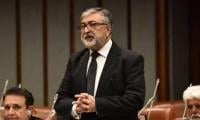An alliance of public and private health care institutions, supported by the Sindh government, has launched the Pakistan Life Savers Programme (PLSP), an initiative to train 10 million Pakistanis in key skills, such as CPR, cardiopulmonary resuscitation and bleeding control, at an event at the Aga Khan University (AKU).
The PLSP aims to reduce the burden of death and disability from two major causes of death — cardiac arrest (when the heart suddenly stops beating) and blood loss from injuries — through a nationwide training plan that will teach citizens how to perform simple measures that can improve an individual’s chances of survival.
Preventing deaths from cardiac arrest and injuries, such as road accidents, gunshot wounds and serious household mishaps, requires a strong chain of survival. This chain is a sequence of critical actions that starts at the incident site and ends at the hospital.
Trained bystanders represent the first link in the chain and can play a vital role in improving survival rates after these two life-threatening circumstances.
Since the majority of cardiac arrest and injuries cases occur out of hospital, Pakistan needs a critical mass of citizen rescuers who can act as a bridge in the health care system and provide essential support before a patient is taken to a hospital for care.
“As physicians we feel a sense of powerlessness when we see cardiac arrest or injury patients come to the emergency room,” said Dr Noor Baig, a senior instructor in emergency medicine at the AKU.
“In the majority of cases, these patients arrive at the hospital when it’s too late, as they have either lost too much blood or their heart has stopped beating for too long.”
If a trained bystander can provide early vital care by recognising a cardiac arrest or massive bleeding, activating the emergency system and applying CPR or measures to stop the bleed, doctors would be in a better position to treat patients, Dr Baig concluded.
The PLSP is a multi-stakeholder collaboration whose members include the AKU, the Aman Healthcare Services, the Dow University of Health Sciences, the Edhi Foundation, the First Response Initiative of Pakistan, the International Committee of the Red Cross, the Jinnah Postgraduate Medical Centre, the Mukhtar A Sheikh Hospital, the National Institute of Cardiovascular Diseases, the Shaheed Mohtarma Benazir Bhutto Institute of Trauma, the provincial government and the Ziauddin University.
Emergency medicine specialists at the PLSP launch event at the 5th AKU Annual Surgical Conference noted that countries such as Japan, Singapore, Ireland and the United States of America have benefited greatly from similar initiatives to train citizens in CPR and bleed control.
The PLSP will be launched in Karachi where hundreds of volunteers from the alliance will impart CPR and bleed control skills to trainers.
This group will then teach the same content to school and college students with each session guiding participants to assess the individual’s condition and ensure scene safety; communicate with emergency response services; initiate chest compressions in the case of cardiac arrest or apply tourniquets and other bleed control measures for injuries and disseminate preventive public health messages.
The programme will start in Karachi this year. It will then be expanded across Sindh and other provinces in line with its goal of training 10 million people across the country over a decade.
“Every member of society should be trained in life-saving skills,” said Dr Junaid Razzak, director of the AKU’s Centre of Excellence for Trauma & Emergencies.
“Besides imparting life-saving skills, the [PLSP] seeks to instil a sense of leadership and civic responsibility. Each preventable death represents an enormous loss to our country and [the] PLSP seeks to empower Pakistanis to protect their loved ones and fellow citizens from harm.”
Speakers at the event noted that they aim to partner with schools to scale up the number of training sessions provided.
Sindh Minister for Human Settlement Ghulam Murtaza Baloch expressed support for the PLSP and mentioned that he was involved in discussions to contribute to the success of the programme.
“[The] Government of Sindh is committed to the success of the programme and will provide support from health and education departments as well as necessary legislation such as protection of bystander bill and adding PLSP training content to school and college curricula.”
A tripartite memorandum of understanding was signed by AKU Medical College Dean Dr Adil Haider, Sindh Secretary for College Education & Literacy Rafique Buriro and Special Secretary for Health Fayaz Hussain Abbasi.
The PLSP has been initiated by the AKU’s Centre of Excellence for Trauma & Emergencies and is supported by the university’s MBBS class of 1994 and by the Mukhtar A Sheikh hospital in Multan.
The programme is part of the AKU’s efforts to achieve targets under the Sustainable Development Goal (SDG) 3: to ensure healthy lives and promote well-being for all ages.
Targets under the goal call for measures to reduce the burden of deaths caused by non-communicable diseases, such as cardiovascular conditions, and to halve deaths and disabilities resulting from road traffic accidents, which is a major cause of injury in Pakistan.
Injury deaths
Thousands of injury deaths every year in Pakistan can be averted by taking safety measures on one side and by adopting a systematic approach to improve trauma care on the other, said experts while speaking at the inaugural session of the annual conference. This year’s focus is on ‘Trauma: Striving for Change’.
A systematic approach ensures that life-saving interventions are performed in a timely manner and that no life-threatening conditions are missed, speakers at the event noted.
According to the World Health Organisation’s guidelines, such an approach could consist of emergency care in the form of first aid being provided by a trained bystander, who can also call an ambulance, equipped with necessary life support and at least two personnel: one to monitor and manage the patient and the other to drive.
Ambulance personnel should be able to communicate to a relevant hospital prior to arrival, if needed. During the handover, the ambulance provider should share critical information with hospital personnel, who then triage patients to different areas based on the seriousness of their condition.
Research from the conference was published in a special supplement of the Journal of the Pakistan Medical Association. During the event, Prof Syed Ather Enam, chair of the Department of Surgery at the AKU, referred to a case report of a two-and-a-half-year-old boy, who sustained three gunshots at point-blank range.
The child was unresponsive when the terrified family brought him to the emergency department of the AKU Hospital after trying two nearby health facilities.
When the patient did not respond to initial resuscitation efforts, a team of paediatric, cardiothoracic and orthopaedic surgery, and paediatric anaesthesiology specialists was taken on board and he was moved to the operating room immediately.
“Today, he is a healthy four-and-a-half-year-old school-going child. There could be thousands of people who were not lucky like him. That’s because our hospitals lack multidisciplinary teams of specialists and the emergency care system as a whole is short of fully equipped ambulances and trained bystanders,” said Prof Enam.
The AKU’s Annual Surgical Conference brought together national and international experts with expertise in pre-hospital care, mass casualty, rehabilitation, prevention and disaster management.
“Since blood loss is the leading cause of preventable death following injury, rapid control of bleeding at the scene of an event can be life-saving, especially if bystanders can step in to help before emergency responders arrive,” said Eileen Bulger, a professor of surgery at the University of Washington.
Emergency care is essential to many targets of the United Nations’ SDGs. Under SDG 3, good health and well-being: post-crash emergency care and rehabilitation has been estimated to play a role in preventing 40 per cent of road traffic deaths. Also, timely emergency care access is critical to effective universal health coverage.
Emergency care can also contribute to efforts to achieve targets under 10 more SDGs by addressing non-communicable diseases, obstetric complications, child health issues, and injuries related to disasters and violence, informed Hasan Badre Alam, a professor of surgery at the University of Michigan.
AKU Vice Provost Anjum Halai, Medical College Dean Adil Haider and chair of the event’s organising committee Hasnain Zafar also spoke at the conference.
The Annual AKU Surgical Conference, organised by the Department of Surgery at the AKU in Karachi, offers unparalleled hands-on and didactic learning opportunities, timely discourse on the most relevant surgical practices and research, and networking with peers. The last year’s conference focused on global surgery.
An aerial view of the commercial district of Pakistan's port city of Karachi. — AFP/FileResearch conferenceThe Indus...
Police personnel stand alert in Karachi on February 2, 2024. — INPA comprehensive security is in place for the...
Sindh Chief Secretary Syed Asif Hyder Shah chairs a meeting on March 14, 2024. — Facebook@Sindh Government In a...
An undated image of the Dow University of Health Sciences . — AFP/FileThe Dow University Hospital’s Renal...
Karachi Mayor Barrister Murtaza Wahab speaks with someone in this image. — APP/File Karachi Mayor Barrister Murtaza...
Sindh Senior Minister Sharjeel Inam Memon addresses media persons during press conference, in Karachi on April 11,...







